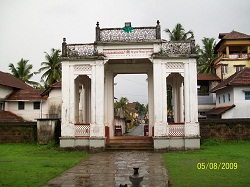The 1000 pillar Jain Temple of Moodabidri is an uncrowned world heritage site in the outskirts of Mangalore. Located in Moodabidri which is also called Jain Kashi, the 1000 Pillar Jain Temple, is a 2 storied structure built on Granite and is a splendid specimen of the famed Vijayanagar style of architecture. The fine carvings on the Pillars are about the life and times of the Theertankaras as well as Lord Rama and Krishna.
Moodabidri is 37 Kms northeast from the port city of Mangalore. It is situated on National Highway 13 in Mangalore-Karkala road. Mangalore can be reached by both Air and Rail. Taxis are the best way to explore Moodabidri.

Brief History of 1000 Pillar Jain Temple
Jainism had its origins in Moodabidri in the 12th Century AD. Under the patronage of the Vijayanagar Kings, it flourished in Moodabidri and its surrounding areas. In the early 1400s Charukirti Battaraka, the head priest of Jain Mutt requested the Vijayanagar King for a piece of land to build a temple. The King granted the land and in 1430 the 1000 Pillar Jain Temple was built with the help of wealthy merchants and the local community. The 1000 Pillar Jain Temple is the most magnificent of the 18 Jain Temples in Moodabidri. It is dedicated to Chandranatha, the 8th Theertankara of Jains.
The 1000 pillar Jain Temple
The 1000 Pillar Jain Temple is today one of the most popular Temples for the Jains. The Temple is divided into 7 parts- The Manasthambha, Bhairadevi Mandapa, Gaddige Mandapa, Namaskara Mandapa, Theerankara Mandapa, Lakshmi Mandapa and the Garbha Griha or the Sanctum Sanctorum.

The walls in the Temple carry inscriptions of how the construction was undertaken. It was built in 3 stages. In 1430, the main section with the presiding deity of Chandranatha was completed. In 1451 Bhairadevi Mantapa, the second stage of construction was completed. The Queen of the Jain Ruler completed the 15-meter tall freestanding single stone pillar called Manasthambha in 1462.

The ground floor of the Temple Complex houses the Main Building, the Bhairadevi Mantapa and the Manasthambha. The main deity of Chandranatha is 9 feet and is made of Panchaloha or 5 metals. The main hall looks majestic with a number of ornate pillars. What is remarkable is that no two pillars are identical. Carvings in Vijaynagara Style adorn the pillars and roof of the hall. The second floor has carvings of all the 24 Theertankaras of Jainism. The 300 miniature Crystal Statues are magnificent.There are also some stone inscriptions in the temple in Halegannada or old Kannada.

Time as well as man-made issues like Mining is taking a toll on this Temple. Fortunately Indian National Trust for Art and Cultural Heritage (INTACH) has noticed this and adopted the 1000 Pillar Temple and is actively carrying out conservation efforts.
Ancient Literature on Jain Temple
Moodabidri was a major center of Literature in Medieval times. One of its most famous sons was Ratnakara Varni, the author of Bharatesha Vaibhava. Several priceless Jain Manuscripts are in the possession of Monasteries here, Dhavala texts being the most famous of them. Many of the Manuscripts were originally in Shravanabelagola and had to be shifted to Moodabidri during the Mughal conquest. Most of them are Prakrit texts copied in old Hale-Kannada script, with pinpricks on palm leaves.

A Discovery at Moodabidri Jain Temple
Moodabidri was a trading center in the 15th century. Carvings of Giraffe and Dragons inside the Temple show that it had trading ties with Africa and China. Today Moodabidri plays host to Alva’s Viraasat, a national level cultural festival. Musicians and Dancers come here from all parts of India to participate in this festival.